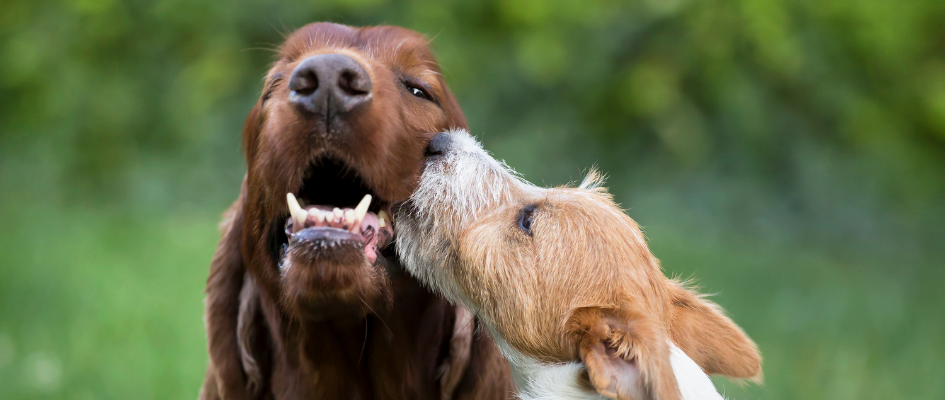Why is it important?
Unlike wolves, who breed according to food supply and the seasons, our domestic male dogs are quite promiscuous creatures. They will mate all year round, at any given opportunity and this can lead to increased risk of roaming, injury, certain diseases, and overpopulation. It can also lead to inappropriate or unattractive behaviours around our homes and families including mounting, humping, and territorial urine marking.
Neutering is the most common surgical procedure carried out on dogs. If you’re trying to decide whether to get your dog ‘done’, it’s worth looking at the arguments for it, against it, and then looking at the procedure.
Advantage 1
Neutering helps reduce the population of abandoned dogs and the passing on of genetic defects.
Advantage 2
It reduces behaviours pet owners often dislike, such as running off to look for bitches in heat (which increases their risk of road accidents or going missing), less sexual behaviour such as masturbation and humping, a reduction in some types of hormonal driven aggression, and territorial urine marking.
Advantage 3
Neutering will prevent your dog from developing a testicular tumour. Neutering also reduces the risk of some prostatic diseases, hernias, and certain cancers of the bottom.
Advantage 4
Studies have shown that neutered dogs have a longer life span compared to unneutered dogs. This is most significant in female dogs, but male neutered dogs have also been shown to live longer than unneutered male dogs.

Disadvantage 1
More or less by definition, a surgically castrated dog’s fertility is permanently removed, so you can’t change your mind. (HOWEVER, remember that he may still have some sperm ‘left over’ for several weeks after the operation, should he get the chance to ‘use’ them!). We do now also have the option of a hormonal implant which will induce a temporary castration for 6 to 12 months. Speak to your vet whether this option is appropriate for your pet.
Disadvantage 2
Weight gain – castrated dogs need fewer calories than entire ones, so you need to feed them less or they’ll put on weight! This weight gain may lead to certain health conditions associated with obesity, such as orthopaedic injuries or osteoarthritis.
Disadvantage 3
Risk of surgery – all surgeries and anaesthetics carry a risk of either mild or more serious complications. The procedure to castrate a male dog is a very routine and low-risk surgery, with very few incidents of serious complications.
How do I decide?
It is important to discuss this with your vet at their six-month health check and then you can make the decision on if and when to neuter your dog. The best time to neuter can depend on the breed and size of your dog. Some male dogs will have a ‘retained testicle’ when the testicle remains in the abdomen and does not descend into the scrotum. It is very important that this is identified at this age, the testicles surgically removed and that your dog is fully castrated. If this is not treated, it increases the risk of undetected testicular cancer.
So, when you’ve made up your mind to have your dog neutered, what is the procedure?
Castrating a dog is a very simple surgery because his reproductive organs are conveniently located outside his body. In the procedure, his testicles are removed (so it is not the same as a vasectomy, where the testicles remain in situ but the tubes carrying sperm from them are cut) preventing him from making either sperm or testosterone – essentially returning his hormone balance to that of a prepubescent puppy. There is no evidence that dogs miss their testicles once they’re gone, nor does castration per se have any effect on their personality or psychological development.

So, what actually happens on the day of the surgery?
We perform castrations as a day surgery, your dog will spend the day with us and will normally be discharged back to your care that evening. The night and morning before the procedure, it’s important to withhold food from midnight, but he should have access to water until he comes to the clinic.
He will be admitted by a member of our team and fully examined by a Vet before his procedure. During the admission process, we will recommend a pre-anaesthetic blood test to check his metabolic function prior to a general anaesthetic and we discuss the surgery, provide an estimate if not already provided and ask you to read and sign a surgical and anaesthetic consent form. It is important an adult is present to give consent for the procedure and that you provide a contact number on which we can contact on the day of the procedure.
Your dog will be kept in a hospital cage with soft bedding and we will give him a ‘pre-med’ injection (a combination of sedation and pain relief to help him relax and reduce any pain following the procedure). Then, when we’re ready, we will give him a general anaesthetic via an intravenous catheter, so he is completely asleep, and pass a breathing tube down his throat to help him breathe. The nurse will scrub the area around his scrotum (ball sack) while the vet scrubs up, and then they’ll begin.
It takes perhaps 15 minutes (a very quick procedure!) as a small incision is made in front of the scrotum, and one at a time the testicles are pulled out of this, clamped and cut off. The arteries and spermatic cords are then tied off with dissolvable stitches, and the skin layers closed with sutures. Remember, the scrotum is not removed – it is normal for your dog to go home with an empty pouch of skin between their back legs. Sometimes there may be some swelling in the scrotum following the surgery, but this should reduce quickly over the coming days.
How long will it take for him to recover?
As soon as he’s awake and his sedatives have worn off, he can go home with a collar on to stop him licking at the wounds until they’ve healed. Most dogs are completely back to normal in a day or so, but it is important to restrict their exercise and keep him on a lead until the wound has healed and any external sutures are removed – this is normally 7-10 days after the surgery.
We will examine him 2-3 days after the surgery to make sure he is healing as expected, and then again at 7 to 10 days post-surgery. He will be discharged with pain relief and a special diet recommendation to help him recover from the anaesthetic.
In conclusion…
Neutering of male dogs does prevent some unpleasant diseases, reduces undesirable behaviours and can increase the lifespan of your pet. It is important to modify their diet and calorie intake post castration to avoid the increased risk of obesity.
If you are still unsure if it is right for your dog, our vets will be happy to discuss with you further at a routine health visit. Unlike in female dogs, the timing of the procedure is less critical to their long-term health, and it is a procedure that can be conducted at any age, although it is best performed before undesirable behaviours become learnt behaviours, or before hormonally induced disease develops.
Don’t forget, ProActive Pets members receive 20% off routine neutering!
